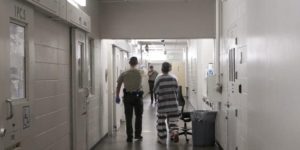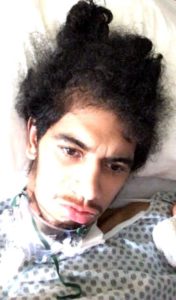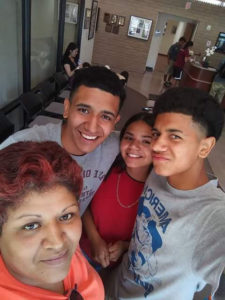Scottsdale Civil Rights Lawyers Advance Arizona Civil Rights Lawsuit for Teenager Left Brain Dead After Beating at 4th Avenue Jail
Scottsdale Civil Rights Lawyers Advance Arizona Civil Rights Lawsuit for Teenager Left Brain Dead After Beating at 4th Avenue Jail
Scottsdale Injury Lawyers has filed a new lawsuit against Maricopa County, its Sherriff and various individuals working at the 4th Avenue Jail in Phoenix, Arizona. The lawsuit was filed on behalf of Brian Ortiz by his mother and guardian. The lawsuit advances civil rights claims under 42 U.S.C. § 1983. The lawsuit was filed in the federal district court of Arizona. It is entitled Ortiz v. Maricopa County, Et Al. and designated case # CV-20-01746-PHX-SPL (DMF). The case has been assigned to Judge Steven P. Logan and Magistrate Judge Deborah M. Fine.
The Events Giving Rise to the Arizona Civil Rights Lawsuit
The lawsuit arises from the near-deadly attack of Brian Ortiz “Brian” by another inmate in the Maricopa County jail system. Brian had just turned 18 years old and was taken to the 4th Avenue Jail for a probation violation. Once at the jail, he was placed in closed custody housing. According to department policy, closed custody housing is for persons who present a serious risk to the life of staff or other inmates, to property or to the orderly operation of the jail. It is unclear as to why Brian was placed in closed custody housing.

On May 26, 2020, under what was supposed to be the watchful eye of detention personnel, Brian was punched, kicked and stomped on by another inmate almost 50 times. He was beaten with such violent force that he fell into a coma and did not regain consciousness for more than two months. During this time he required a ventilator to breathe and IV nutrition through feeding tubes. Specifically, he suffered a diffuse axonal shear injury at the corpus callosum in his brain. His injuries were so severe, that doctors at the hospital where he was taken contacted his mother seeking end of life permission and to have him removed from life support.
…under what was supposed to be the watchful eye of detention personnel, Brian was punched, kicked and stomped on by another inmate almost 50 times.
This was the first that Brian’s mother and family learned of the violent attack. Prior to this, he had been at the hospital for several days and no one from the Sheriff’s Office of jail contacted his family to tell them what happened. In fact, the family learned from medical staff at the hospital that Brian was assaulted at the 4th Avenue Jail. The jail and Sheriff’s Office responsible for his care and custody never informed the family.

Video surveillance of the beating and what followed was reviewed and described in a jail crime report. The surveillance showed that Brian was beaten by another inmate and left on the ground convulsing. The inmate who beat him tried to wake him up, but was unable to do so. That inmate then drug Brian back to his own cell where he placed Brian in his bed. That inmate then took a shower and took cleaning solution to clean up the area where Brian was attacked. All this occurred without any one from the jail taking notice. Brian was eventually found having seizures in his bed and bleeding from his head. During the assault, and in the critical time period following Brian’s traumatic brain injury, no one came to his aid. In fact, Brian was not so much as placed in an ambulance until approximately 2 hours and 15 minutes after he was beaten.
Brian will never be the same, much less a full-functioning adult. He currently requires 24-hour care and medical supervision. He likely always will. At the young age of 18, his life was forever changed due to the failure of the institution and its personnel that were tasked with protecting him.
At the young age of 18, his life was forever changed due to the failure of the institution and its personnel that were tasked with protecting him.
The civil rights lawyers at Scottsdale Injury Lawyers have filed a lawsuit on Brian’s behalf. They have also asserted a claim by his mother for the loss of her relationship with him. The lawsuit seeks compensation for his pain and suffering, his injuries, his physical disability and for the costs of his past and future medical care, among other things.
The Allegations Asserted by Our Scottsdale Civil Rights Lawyers in the Arizona Civil Rights Lawsuit
The exact allegations from the lawsuit are set forth verbatim below:
Maricopa County Sheriff’s Office Policies and Procedures
10. The Maricopa County jail system is comprised of multiple facilities, including the Fourth Avenue Jail located at 201 S. 4th Avenue, Phoenix, Arizona 85003.
- The Fourth Avenue Jail houses the highest security inmates in the Maricopa County jail system. However, it is not considered a direct supervision housing unit.
- Among the inmate housing categories within the jail system is what is known as Closed Custody Housing. According to MCSO Policy Number DI-1, this housing is for persons who present a serious risk to the life of staff or other inmates, to property or to the orderly operation of the jail.
- Policy Number DI-1 also dictates that Closed Custody “inmates shall be housed in a maximum-security jail facility, may be denied contact with other inmates, and may be locked in their cells for up to 23 hours daily.”
- Regarding inmate supervision, Policy Number DH-6 requires 24-hour supervision of all inmates at each jail facility, and that supervision is the responsibility of detention personnel. Policy Number DH-6 does not detail the manner of the supervision other than in direct supervision housing units.
- Policy Number DH-6 also requires detention officers assigned to each housing unit to undertake security walks over the course of their shifts to ensure the well-being and safety of each inmate.
- Healthcare services are provided to inmates by Correctional Health Services (“CHS”), which is an administrative subdivision of Maricopa County.
- Under Policy Number DQ-1, decisions regarding the level and urgency of inmate care are the responsibility of CHS staff. Decisions concerning the security of staff and inmates in providing healthcare services are the responsibility of the MCSO.
- Policy Number DQ-1 also proscribes procedures for emergency medical treatment. These include that CHS staff members are responsible for directing the particular level of care. However, an MCSO supervisor may request an ambulance before notifying CHS if it is believed that an inmate is suffering from a life-threatening condition.
- Policy Number DQ-1 further outlines procedures for MCSO detention personnel in regard to emergency medical treatment. These include that MCSO detention personnel may request emergency treatment for an inmate if it is believed to be warranted. Also, detention personnel shall immediately contact CHS staff if he or she believes there is a medical emergency.
- In addition, Policy Number DQ-1 requires a nurse to request an ambulance if life-sustaining equipment is needed.
- Policy Number GJ-11 establishes procedures applicable to incidents involving illness, serious injury or death of an inmate.
- Pursuant to Policy Number GJ-11, a detention officer must immediately seek or request medical attention for an inmate who is seriously injured or unconscious. Also, the shift supervisor must be notified of the incident.
- Further, Policy Number GJ-11 requires detention officers to promptly administer needed emergency medical care, including CPR or first aid. And if there is a life-threatening emergency, a detention officer must call the fire department for emergency medical personnel.
The Attack of Brian Ortiz Under the Supervision of Detention Personnel
- On May 26, 2020, Brian Ortiz was an inmate at the Fourth Avenue Jail. Ortiz was in Closed Custody housing and was assigned to cell 1.03, which was located in housing unit 4A, 100 pod (the “Pod”).
- Three other inmates housed in the Pod on May 26, 2020, were Fregoso (“Fregoso”), Amaya (“Amaya”) and Murphy (“Murphy”). Fregoso was assigned to cell 1.06, Amaya to cell 1.07 and Murphy to cell 1.05.
- That morning, Fregoso approached the cell of Amaya. The two inmates had a conversation, and Amaya passed certain items under his cell door to Fregoso.
- Shortly after, at approximately 7:40 a.m., Mr. Ortiz, Fregoso and Murphy were on dayroom access. At that time, Mr. Ortiz and Murphy were walking by the cell of Fregoso. Fregoso, who was near the back of his assigned cell, started a conversation with Mr. Ortiz. Fregoso then directed Mr. Ortiz’s attention to something on the table inside Fregoso’s cell.
- At approximately 7:41 a.m., Mr. Ortiz entered the cell of Fregoso.
- In the cell, Fregoso delivered closed fist strikes to the groin and face of Mr. Ortiz, knocking him against the wall before he fell to the ground. Fregoso then repeatedly stomped on Mr. Ortiz’s head and face before again punching him. Approximately 16 punches and 32 foots-stomps were doled out during the beating.
- At approximately 7:42 a.m., Fregoso exited his cell alone. He then approached Amaya and began laughing and appeared to be bragging about what had occurred. Fregoso then spoke with Murphy who exited his assigned cell and looked into Fregoso’s cell. Murphy joined Fregoso in laughing at Mr. Ortiz who was still unconscious on the floor in Fregoso’s cell.
- At approximately 7:43 a.m., Fregoso returned to his cell and observed Mr. Ortiz still lying on the ground unconscious.
- At approximately 7:44 a.m., Fregoso exited his cell, retrieved cleaning solution and walked back to his cell. Along the way, he was laughing and appeared to be bragging to Amaya and Murphy.
- At approximately 7:45 a.m., Fregoso entered his assigned cell. Fregoso used his foot to nudge Mr. Ortiz, who remained unconscious on the floor of the cell. Fregoso then exited his cell and again spoke with Amaya.
- At approximately 7:49 a.m., Fregoso entered his assigned cell and attempted to lift Mr. Ortiz and get him to stand under his own power. However, Mr. Ortiz was still unconscious and unable to stand, and so Fregoso laid him back down on the cell floor.
- At approximately 7:50 a.m., Ortiz was seizing.
- At approximately 7:52 a.m., Fregoso dragged Mr. Ortiz to Mr. Ortiz’s assigned cell and placed him on his mattress.
- At approximately 7:57 a.m., Fregoso poured cleaning solution from the back of his assigned cell toward the doorway. He also used a towel to clean Mr. Ortiz’s blood from the cell. He then went to the shower and rinsed the towel.
- During the 15–20-minute period following the attack of Mr. Ortiz, Fregoso stopped to speak with Amaya 13 times.
- The above events were all recorded by the jail’s video surveillance system.
- At approximately 8:00 a.m., Defendant Officers Kaiser and Samaniego conducted a security walk in the Pod. During the security walk, they saw that Mr. Ortiz was in his cell unconscious. Kaiser and Samaniego took no additional action.
- At approximately 8:50 a.m., Defendants Kaiser and Samaniego began another security walk in the Pod. On this subsequent walk, Defendant Kaiser stopped and spoke with Inmates Fregoso and Amaya.
- Defendants Kaiser and Samaniego then continued their security walk. They again passed by an unconscious Mr. Ortiz without any further action.
- Later that morning, at about 9:15 a.m., Defendants Collett, Dugalic, Rose and Maria were conducting medical rounds in the Pod.
- During their rounds, they stopped at Mr. Ortiz’s cell for a potential blood pressure assessment. When they did so, Defendant Collett looked into the cell and saw that Mr. Ortiz was non-responsive and was seizing.
- Upon viewing Mr. Ortiz, Defendant Collett did not promptly administer medical care, nor did she request an ambulance. Instead, Collett asked Defendants Rosie and Maria to look at Mr. Ortiz and to give their opinions as to whether they also believed Mr. Ortiz was seizing.
- Defendant Collett then radioed in a “man down” to security control and requested additional officers and staff.
- At approximately 9:17 a.m., Defendants Newman, Griego, Kaiser, Rice, Samaniego and Weaver arrived at Mr. Ortiz’s cell. A Code 4 was also called by Defendant Dugalic at this time.
- The officers and medical staff at the scene saw that Mr. Ortiz was non-responsive and was seizing and that he had blood coming out of his ear. However, each one of the defendants failed to promptly administer emergency medical care, to call for emergency medical personnel or to call for an ambulance.
- Before entering the cell, Defendant Newman ordered Defendant Rice to retrieve a shield from the level 4 control office.
- Defendants then secured Mr. Ortiz with restraints around his hands, a belly belt and leg chains, before placing him on a backboard. During this time Mr. Ortiz was unconscious, non-responsive, had swelling to his face and was bleeding from his head. During this process, each defendant failed to administer emergency medical care or to summon emergency medical personnel or an ambulance.
- At 9:25 a.m., approximately 1 hour and 45 minutes after he was nearly beaten to death, Mr. Ortiz was taken out of his cell on a backboard, placed on a gurney and taken to the facility’s level 4 medical clinic.
- At the medical clinic, Mr. Ortiz was examined by Defendant Bevels.
- Bevels authorized an ambulance transport to Banner – University Medical Center Phoenix (formerly Good Samaritan Hospital) “to rule out head trauma.”
- At 9:55 a.m., half an hour after Mr. Ortiz was taken to the medical clinic—and 2 hours and 15 minutes after the attack—Mr. Ortiz was placed in an ambulance.
- During the above-described events, Defendant Dean was assigned to the control tower. From the control tower, an officer can supervise inmates by way of the video surveillance system, which provides 100% coverage of the facility.
- As a result of the attack, Mr. Ortiz suffered a severe traumatic brain injury and was comatose for more than two months. More specifically, his injuries included autonomic dysfunction, diffuse axonal brain injury, severe protein-calorie malnutrition, acute respiratory failure, coma, post-traumatic seizures, left hemiplegia, TBI (traumatic brain injury), traumatic subarachnoid hemorrhage with coma, dependence on respirator, diffuse traumatic brain injury with loss of consciousness greater than 24 hours without return to pre-existing conscious level, encephalopathy, hyperosmolality and hypernatremia, and pneumonia due to Klebsiella pneumoniae.
- Ortiz was never told by the Maricopa County Sheriff’s Office or any of its employees that her son had been attacked and had suffered serious injuries. Instead, on June 1, 2020, she was contacted by someone from the hospital who told her, for the first time, that her son was in critical condition and on life support.
- On June 3, 2020, medical professionals at the hospital asked Ms. Ortiz for permission to take her son off life support and she refused.
The Civil Rights Claims Advanced by Our Arizona Civil Rights Lawyers
This shocking series of events was the result of the deliberate indifference to the safety and serious medical needs of Brian by Maricopa County, its Sheriff, and the jail’s detention officers and medical staff. The acts and omissions alleged in the civil rights lawsuit deprived Brian of his rights under the Eighth Amendment to the United States Constitution. They also deprived Brian and his mother of the companionship and society of each other in violation of the Fourteenth Amendment.



The civil rights lawsuit our attorneys filed advances claims under 42 U.S.C. § 1983 for deliberate indifference to the medical needs of a prisoner in violation of the 8th Amendment. This includes claims against the individual personnel who were present that day. It also includes claims against Sheriff Penzone in his supervisory and individual capacity for his repeated failures to address the serious medical needs of inmates at the jail. Finally, a claim was advanced against Maricopa County based on the acts of Penzone as a final policy maker and for failure to properly train jail personnel.
An additional 8th Amendment violation claim was brought for failing to protect Brian. This was asserted against the deputy tasked with monitoring and supervising Brian and the inmates by way of the video surveillance system. This claim was also asserted against Penzone in his supervisory capacity alleging that Penzone was aware that the deputies, which he controlled, had a history of deliberate indifference to inmate safety.
A final claim was advanced against all defendants for interference with the parent-child relationship between Brian and his mother. This was brought pursuant to 42 U.S.C. § 1983 for a violation of the 14th Amendment. The 14th Amendment sets forth “nor shall any state deprive any person of life, liberty or property, without due process of law; nor deny to any person within its jurisdiction the equal protection of the laws.
**If you have information regarding this case, please contact Scottsdale Injury Laywers today.**
Contact an Arizona Civil Rights Lawyer to Discuss Your Civil Rights Case
If you or a loved one has suffered a violation of your civil rights, contact the Arizona civil rights lawyers at Scottsdale Injury Lawyers today. An experienced civil rights lawyer is available now to discuss your case at no cost. Our firm has experience handling civil rights cases for both prisoners and free individuals. We handle civil rights cases involving: police brutality, unlawful arrest, 1st Amendment/free speech retaliation, unlawful search and seizure, excessive force, wrongful shooting, wrongful tasering, police dog or police K9 attacks, deliberate indifference to medical needs, cruel and unusual punishment, failure to protect, 4th Amendment violations, 8th Amendment violations, 14th Amendment violations and unlawful detention, among other claims.
About the author: The content on this page was provided by Scottsdale personal injury attorney and Arizona civil rights lawyer Tony Piccuta. Piccuta graduated with honors from Indiana University-Maurer School of Law in Bloomington, Indiana (Ranked Top 35 US News & World Report 2018). Piccuta took and passed the State bars of Arizona, California, Illinois and Nevada (all on the first try). He actively practices throughout Arizona and California. He is a trial attorney that regularly handles serious personal injury cases and civil rights lawsuits. He has obtained six and seven figure verdicts in both state and federal court. He has been recognized by Super Lawyers for six years straight. He is a member of the Arizona Association of Justice, Maricopa County Bar Association, Scottsdale Bar Association, American Association for Justice, National Police Accountability Project and Consumer Attorneys of California, among other organizations.
Disclaimer: The information on this web site is for informational purposes only and does not constitute legal advice. The information on this page is attorney advertising. Reading and relying upon the content on this page does not create an attorney-client relationship. If you are seeking legal advice, you should contact our law firm for a free consultation and to discuss your specific case and issues.
[1] https://www.law.cornell.edu/uscode/text/42/1983
[2] https://www.law.cornell.edu/constitution/eighth_amendment
[3] https://www.law.cornell.edu/constitution/amendmentxiv

